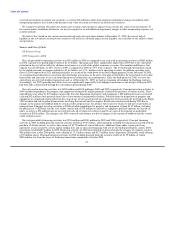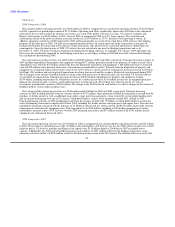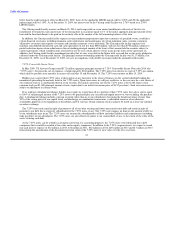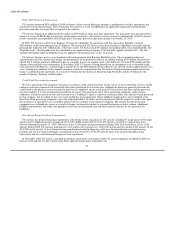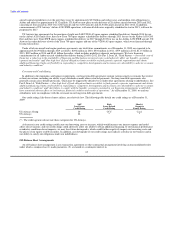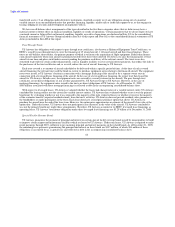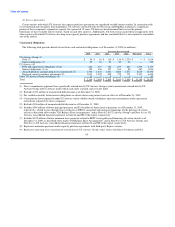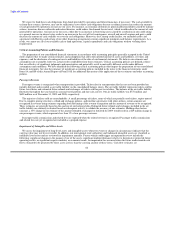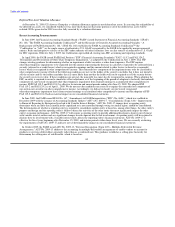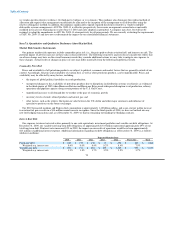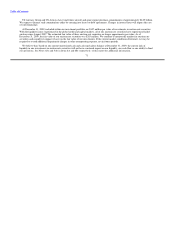US Airways 2009 Annual Report Download - page 69
Download and view the complete annual report
Please find page 69 of the 2009 US Airways annual report below. You can navigate through the pages in the report by either clicking on the pages listed below, or by using the keyword search tool below to find specific information within the annual report.
Table of Contents
based on historical results adjusted to reflect management's best estimate of future market and operating conditions. The net carrying
value of assets not recoverable is reduced to fair value. Estimates of fair value represent management's best estimate based on appraisals,
industry trends and reference to market rates and transactions. Changes in industry capacity and demand for air transportation can
significantly impact the fair value of aircraft and related assets.
We performed the annual impairment test on our international route authorities and trademarks during the fourth quarter of 2009. The
fair values of international route authorities were assessed using the market approach. The market approach took into consideration
relevant supply and demand factors at the related airport locations as well as available market sale and lease data. For trademarks, we
utilized a form of the income approach known as the relief-from-royalty method. As a result of our annual impairment test on
international route authorities, we recorded a $16 million impairment charge related to the decline in value of certain international routes.
We will perform our next annual impairment test on October 1, 2010.
Investments in Marketable Securities
As of December 31, 2009, all noncurrent investments in marketable securities, consisting entirely of auction rate securities, are
classified as available for sale. We determine the appropriate classification of securities at the time of purchase and re-evaluate such
designation as of each balance sheet date.
Our available-for-sale securities are measured at fair value on a recurring basis. Fair value is an exit price, representing the amount that
would be received to sell an asset or paid to transfer a liability in an orderly transaction between market participants. As such, fair value is
a market-based measurement that should be determined based on assumptions that market participants would use in pricing an asset or
liability. We use a three-tier fair value hierarchy, which prioritizes the inputs used in measuring fair value as follows:
Level 1. Observable inputs such as quoted prices in active markets;
Level 2. Inputs, other than the quoted prices in active markets, that are observable either directly or indirectly; and
Level 3. Unobservable inputs in which there is little or no market data, which require the reporting entity to develop its own
assumptions.
We estimate the fair value of our auction rate securities based on the following: (i) the underlying structure of each security; (ii) the
present value of future principal and interest payments discounted at rates considered to reflect current market conditions;
(iii) consideration of the probabilities of default, passing a future auction, or repurchase at par for each period; and (iv) estimates of the
recovery rates in the event of default for each security. These estimated fair values could change significantly based on future market
conditions.
We review declines in the fair value of our investments in marketable securities to determine the classification of the impairment as
temporary or other-than-temporary. A temporary impairment charge results in an unrealized loss being recorded in the other
comprehensive income component of stockholders' equity. An other-than-temporary impairment charge must be separated into the
amount representing the decrease in cash flows expected to be collected from a security (referred to as credit losses) which is recognized
in earnings and the amount related to other factors (referred to as noncredit losses) which is recognized in other comprehensive income.
This noncredit loss component of the impairment may only be classified in other comprehensive income if both of the following
conditions are met (a) the holder of the security concludes that it does not intend to sell the security and (b) the holder concludes that it is
more likely than not that the holder will not be required to sell the security before the security recovers its value. If these conditions are
not met, the noncredit loss must also be recognized in earnings. We review our investments on an ongoing basis for indications of
possible impairment, and if impairment is identified, we determine whether the impairment is temporary or other-than-temporary.
Determination of whether the impairment is temporary or other-than-temporary requires significant judgment. The primary factors that
we consider in classifying the impairment include the extent and period of time the fair value of each investment has declined below its
cost basis, the expected holding or recovery period for each investment, and our intent and ability to hold each investment until recovery.
Subsequent increases in the fair value of our investments in marketable securities are recorded to other comprehensive income and
accreted to interest income over the period the gains are expected to be realized.
67


